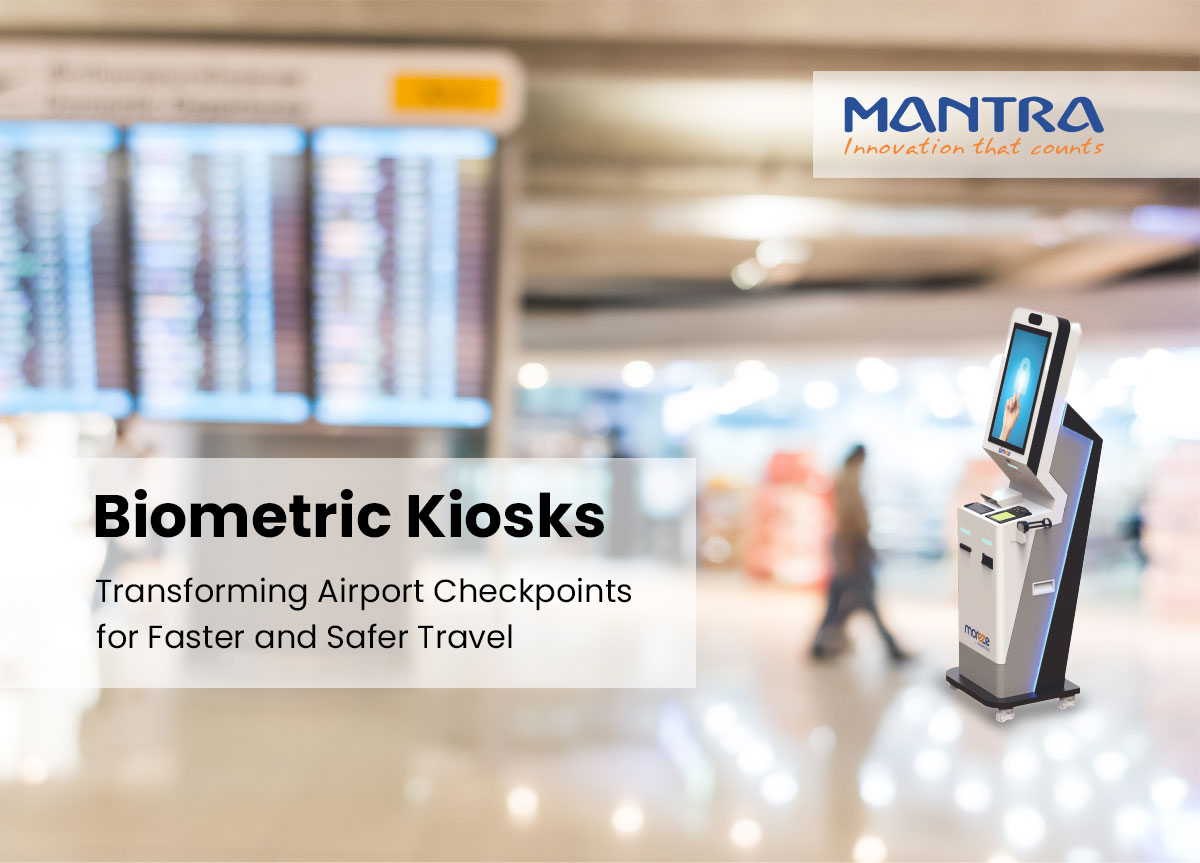Biometric Kiosks: Transforming Airport Checkpoints for Faster and Safer Travel

Imagine a world where airport security lines are a distinct memory, check-in is as simple as a glance, and boarding is a breeze. This vision of seamless air travel is rapidly becoming a reality, thanks to the expanding field of biometric technology. With the help of biometric kiosks, it is redefining the travel experience by making it faster, more convenient, and secure.
The Challenges of Traditional Airport Checkpoints
Air travel, while connecting us to the world, often comes with its frustrating bottlenecks. These bottlenecks include long queues, tedious document checks, and the ever-present security breaches. However, a revolutionary shift is underway, driven by the rapid advancement of biometric technology. Enter biometric kiosks, a game-changing innovation, transforming the airport experience by utilizing unique traits like fingerprints, facial recognition, and iris scans, making it faster, more secure, and more convenient for travelers.
For instance, passengers can use these kiosks to complete check-ins, drop off their luggage, and even clear security faster by scanning their faces or facial recognition. This is just an example; let’s see what other benefits the biometric kiosk can potentially provide.
Elevating Travel: Biometric Kiosks Redefining Airports
Although speed is an important aspect of airport management, security is the backbone. Traditional Methods such as Passport and ID verification can be slow and tedious, prone to human error, and vulnerable to phishing attacks. This is where Mantra Smart Identity’s biometric kiosks emerge as the rising star. But, here is the question that can arise: What are Biometric Kiosks?
These Self-Service Kiosks are advanced biometric systems designed to automate identity verification. They offer high security by ensuring only authorized personnel can proceed through checkpoints. Biometric authentication, such as fingerprints, facial recognition, or even iris scans of passengers, helps verify unique traits against secure, encrypted databases in real-time.
These precautionary steps will make impersonating individuals difficult or use fake documents to do the same. Biometric kiosks will provide a trustworthy and effective way to verify identities, offering peace for travelers and airport authorities. So how does this work?
The process at a biometric kiosk typically involves three main steps:
Data Capture
The Kiosk will capture the unique biometric data of the passenger.
Verification
The stored data is compared to those stored in the secure government or airline database for the verification process.
Authentication
Once the compared data is matched, the system will give the passenger clearance to proceed to the next stage of their journey. In this manner, integrating biometric kiosks will reduce the wait time, long queues, and human dependency, leading to enhanced accuracy of identity verification. But the question is: Where can we use biometric kiosks in airports? Let’s find out in the next section.
How Will Kiosks Be Useful in the Airport?
Biometric kiosks can play a significant role in several airport processes, enhancing operational efficiency and passenger experience.
Faster Immigration & Custom Processing
Biometric Kiosks enable travelers to check in, verify their identity, and complete security checks without hassle. These kiosks significantly cut waiting times and enhance passenger throughput by reducing traditional and manual verification dependency.
Robust Security Measures
Airports can adopt advanced biometric authentication to ensure each traveler's identity is verified with high accuracy, reducing the chances of ID theft. Integrating a real-time database further helps identify potential identity theft threats and provides a robust security framework.
Enhanced Passenger Experience
Biometric Kiosk offers a touchless and hassle-free experience for passengers. Whether self-check-ins, baggage drop, or immigration clearance, the seamless interaction makes traveling less stressful and enjoyable.
Cost Efficiency for Airports
Automating processes reduces the need for extensive manpower, cutting operational costs. Additionally, the efficiency of biometric kiosks minimizes delays & ensures better resource allocation.
Contactless Travel
Due to the COVID-19 pandemic, many industries are prioritizing contactless services. Biometric kiosks enable touchless identity verification, reducing the need for physical contact with documents or any surfaces. This enhances hygiene and aligns with the growing demand for safer travel options.
Global Standardization
As more airports adopt biometric technology, there is potential for greater standardization across the aviation industry. This could lead to a more consistent and efficient travel experience. For passengers traveling abroad, biometric systems become interoperable between the countries and airlines.
Challenges and Considerations
While biometric kiosks offer numerous benefits, their adoption is not without challenges:
Privacy Concerns
The collection and storage of biometric data raise privacy concerns among passengers. Airports must ensure that data is securely stored, encrypted, and used only for its intended purpose. Transparent policies and compliance with data protection regulations (e.g., GDPR) are essential.
Initial Costs
Implementing biometric kiosks requires significant investment in technology and infrastructure. However, the long-term benefits, such as improved efficiency and passenger satisfaction, often outweigh the initial costs.
Technical Limitations
Biometric systems must be highly accurate and reliable to avoid false rejections or acceptances. Factors such as lighting conditions, camera quality, and changes in a passenger's appearance (e.g., aging or facial hair) can affect performance.
Passenger Adoption
Some travelers may hesitate to use biometric kiosks due to unfamiliarity or concerns about privacy. Airports must educate passengers about the benefits and security measures to encourage adoption.
Conclusion
Biometric kiosks are transforming airport checkpoints, offering a faster, safer, and more convenient travel experience. By leveraging cutting-edge technology, airports can streamline operations, enhance security, and meet the evolving expectations of modern travelers. While challenges remain, the benefits of biometric kiosks are undeniable, paving the way for a future where air travel is more seamless and enjoyable than ever before.
As we look ahead, it's clear that biometric technology will play a central role in shaping the airports of tomorrow. So the next time you travel, keep an eye out for those sleek, high-tech kiosks-they might make your journey smoother. Safe travels!